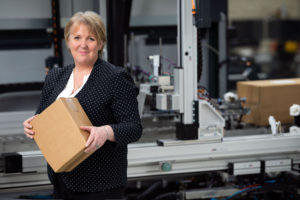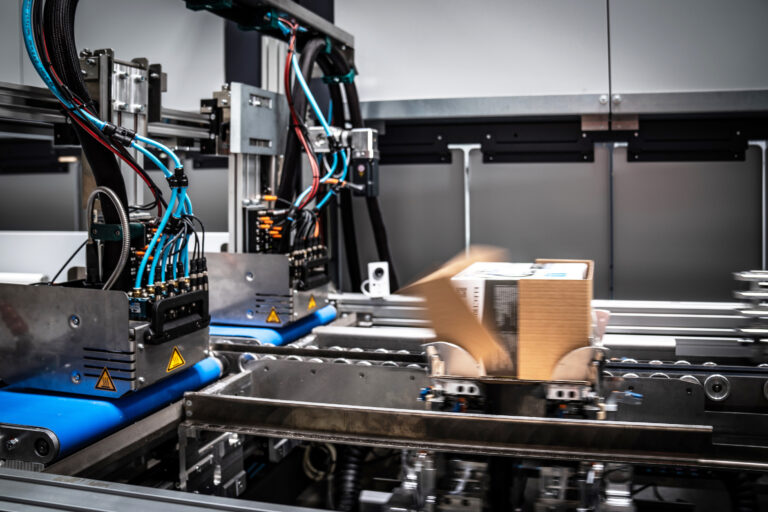The spike in e-commerce sales due to Covid-19 has led to an excess of packaging used to get various goods to consumers as quickly as possible. But what is the environmental cost of these excess orders and can companies keep up with customer demand without compromising on the environment? Michelle Mooney investigates.
The forthcoming Christmas peak is at the forefront of the minds of logistics planners. Covid-19 has driven huge increases in e-commerce volumes in recent months, and with the prospect of the biggest ever online Christmas to pick and pack the pressure will be on the cost-effective and sustainable use of packaging – and keep staff safe in the process.
Jo Bradley, business development manager at Packaging by Quadient UK, says that the packaging of online orders for despatch is typically a manual process, often requiring scores of people “perhaps one hundred or more” packing parcels and processing orders at packing benches placed in close proximity to one another.

In such circumstances she questions as to how social distancing can be achieved under such circumstances, as warehouse space is expensive and may not necessarily be available.
“At peak, the traditional approach taken by most e-commerce businesses is to take on extra staff for that period. However, in the new normal, where demand for online deliveries is likely to remain ‘at peak’ for the foreseeable future, how will businesses cope with finding the necessary numbers of workers needed to meet demand, while also finding the extra space required for social distancing?”
Packaging technology, she says, has advanced significantly in the last few years whereby ‘intelligent systems’ have been developed that can ‘rapidly’ tailor-make cartons to the exact size of a product or order quantity, automatically, as required.
“Such systems can construct, tape, weigh and label each parcel in one seamless process,” she explains. “By building the optimum size parcel around the order-items using corrugated packaging, the technology reduces the box size by 50%. This minimises shipping costs throughout the fulfilment process – some e-commerce businesses have been able to remove up to one trailer a day from their distribution operation.”
Pandemic proliferations
It’s not just the impact of the Christmas peak on packaging use that is a concern for logisticians, it is the volume of packaging and packaging waste that has increased during the Covid-19 pandemic says Jennifer Perr, sustainability director at packaging manufacturer at Hi-Cone.
“When social distancing guidelines went into effect, consumers began looking to online platforms for grocery and household goods shopping,” she says. “This, accompanied by slow-downs in recycling systems, resulted in an increase in packaging waste, including products that would normally be collected by local councils. Unfortunately, this problem is not unique to the time of Covid-19, as gaps in recycling infrastructure and resources perpetually result in the waste of retail packaging products
Consumers are still asking for environmentally friendly packaging, says Perr, but companies are tightening their belts as a result of the economic impact of Covid-19.
“With the economy largely on pause, many businesses and manufacturers have hunkered down into survival mode for the time being,” she says, adding that the combination of greater environmentals concerns and greater economic concerns have only served to widen the gap on what consumers want and how much progress businesses can make.
Perr says that if logistics is to continue on the path towards a truly sustainable ‘new normal’, now is not the time for companies to pull away from their sustainability goals: “2020 may end up being the pivotal time for many businesses on their sustainability journeys – accelerating some to the top and leaving others behind.
Pre-lockdown trends
Remember the days before the country went into lockdown, when many high street retailers were trialling ‘packaging free’ aisles where consumers took their own containers and filled them from dispensers?
Mark Dodds, chair of the food, drink, and agriculture sector group at the Chartered Institute of Marketing, says that driven by marketing and social media campaigns by all accounts, these trials were successfully and with many supermarkets were planning to roll the feature out across stores.

“The recent pandemic changed consumer buying behaviour with many consumers switching focused to convenience and maintaining a supply of goods rather than their environmental credentials,” he says.
But it doesn’t mean however that there has not been innovation taking place and he believes there is a real opportunity for innovation in reusable packaging that can be driven by the rising demand for home deliveries.
“A great example of this is being trialled by Tesco, which has started trials with Loop in a scheme where shoppers receive their shopping in reusable packaging. Customers apply for the service via the website and their goods are delivered by courier in re-usable packaging. The courier then collects the packaging, which is taken to a specialist cleaning firm to be cleaned and returned to be reused.
“The beauty of the scheme is the simplicity of use and the assurance that the packaging is professionally cleaned before re-use – building consumer confidence and brand loyalty,” he says.
But it will require a culture shift to make more environmentally sound packaging the norm, and the chances are that as things get back to normal, consumers will once again start to focus on the environmental impact of their purchases, rather than just whether they are available.
Consumers will always be the ones who drive change, says Dodds, citing research by Chartered Institute of Marketing from last year which showed that consumers believe companies use too much packaging when delivering or selling products.
Some 88% of 2,000 adults surveyed across the UK think that their shopping comes with more wrapping than is required, with children’s toys, mobile phones and cosmetics most likely to come in over-elaborate packaging.
But it’s not just e-commerce that is the perpetrator, as the same survey found that a sixth of consumers believe in-store food shopping uses up more plastic than is required.
“Concern among shoppers regarding the use of plastics has left many retailers to race towards plastic-free aisles, requiring whole supply chains to rethink their offerings. It’s no longer good enough for brands to focus on what a product will look like among its competitors on a crowded supermarket shelf. Brands that ignore any element of this can put themselves at a major disadvantage with savvy high-street consumers as the economy opens up again.”







